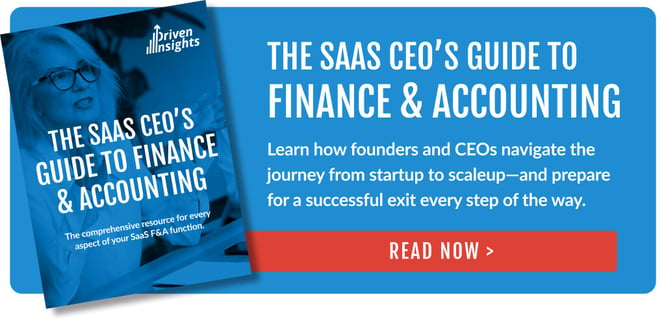
Spreadsheet financial models for SaaS companies stink, whether built in Microsoft Excel or Google Sheets. There, we've said it.
That doesn't mean that spreadsheet models don't provide some value in the very beginning stages of a SaaS business or that the talented people who created them are bad at what they do.
A targeted Google search will produce free models like Gary Gaspar's SaaS financial spreadsheet template and Baremetric's SaaS financial model spreadsheet. At a glance, both look like reasonable starting points, as far as spreadsheet models go. Many endeavor to build their own model - we have, many times - so it's tailored to a firm's specific needs.
But regardless of its origin, you will quickly run into analysis limitations and efficiency issues when using these kinds of spreadsheets to meet accounting standards with financial insights in a live action environment. And make no mistake, SaaS metrics in early stage companies (eg: those still in product/market fit) are of critical importance for a SaaS company.
So, you're stuck, right? Nope.
We're going to offer some suggestions for other solutions below, but first, let's talk about the reasons these financial model spreadsheets will bog your SaaS company down and waste your resources.
7 Problems Which Make Excel Financial Models Stink for SaaS Accounting & Finance
- They're cumbersome. SaaS accounting teams and finance professionals will spend a lot of time inputting data. Much of the data entry can be automated with the tools made by software companies referenced below.
- They're inflexible. It will be difficult or even impossible to evolve these spreadsheets as the financial metrics for SaaS companies change. The KPIs you need to track will vary depending on the stage of growth your company is in (product/market fit, sales model refinement, scale, etc.). If you use spreadsheet models, you will quickly outgrow them and find that you're tracking the wrong SaaS metrics.
- They're complex. When you bring in new employees, you just hope they can pick up the logic and complexities of your accounting methods and these spreadsheets in a reasonable amount of time. When you're leaning on Excel models, there is no easy way to train new team members.
- They aren't scalable. You started this business to grow it, right? These spreadsheets are not built to accommodate the entry or management of bigger data sets.
- They're error-prone. Excel software-as-a-service financial models will include formulas in hundreds or even thousands of cells. That's a lot of opportunity for goof-ups. And, the more manual data entry you use, the more susceptible your systems are to human error.
- They're one-dimensional. Your financial reporting holds the clues to solve many of the problems you'll encounter as you build your SaaS business. You need to continually ask "why?" when you see an abnormality or missed opportunity. But these spreadsheets give you very limited ability to drill down to the level you need to get to in order to uncover these insights. Answering "why?" isn't going to be easy.
- They aren't friendly. They don't play well with others. It may be difficult or even impossible to integrate with other tools like SaaS accounting software solutions, CRMs, or invoicing tools.
What it Would Take to Make an Excel SaaS Financial Model Really Work
What if we lived in a world where no other alternatives to the spreadsheet models existed? Could SaaS accounting teams deal with the above drawbacks and limitations?
If spreadsheets were the only path forward, selecting a model to build from - or to create from a blank spreadsheet - would depend on your products, their subscription dynamics and the present growth phase of your SaaS business. You would consider the nuances of the subscription business model (monthly vs. annual payments, contract length, degree of churn, etc.). In the end, you would need a high-end spreadsheet jockey to build your custom model and keep one on retainer to maintain and evolve it. But even then, you would have limited ability to efficiently segment your data and drill down to perform your ever evolving analysis.
There is a better, faster, more cost effective way.
Options for 3rd Party Providers
We DON'T recommend that you reinvent the wheel to get SaaS financial insights by using Excel financial models. Let's look at options for 3rd-party providers, and then a couple of real-life examples of times when one of these providers proved their worth.- Maxio - As an outsourced finance department provider, we're unapologetic in our praise of Maxio. They're our preferred SaaS accounting software vendor. Their tagline is "complete subscription management for growing B2B SaaS businesses." Featured SaaS accounting reports include "Subscription Momentum" (includes over 90 key subscription momentum calculations), "Cohort Analysis" (shows how churn and retention rates change over time by grouping customers), "Customer Lifetime Value" (measures the profit any given customer will bring to your business), and "Projections" (provides an up to 5 year view of future revenue and billing streams from existing customer contracts and future renewals).
- Recurly - "The subscription management platform delivering unrivaled results to smart brands worldwide." Featured SaaS accounting reports include "Subscriptions by Plan" (compares the performance of your top five plans over time), "Monthly Recurring Revenue" (displays monthly recurring revenue data for up to 18 months), "Subscriber Retention" (provides a cohort analysis showing active and churned subscribers over time), and "Recovered Revenue" (calculates the amount of total revenue recovered by Recurly, segmented by recovery method).
- Other options to check out are TrueRev, Zuora, NetSuite and Intacct.
Tracking Revenue Recognition Problems in your Financial Statements and Beyond
One of the biggest priorities for 2nd-time founders of SaaS businesses is nailing SaaS revenue recognition. Many 1st-timers to SaaS startups don't establish the SaaS accounting systems required to recognize revenue during the period in which it is earned. They lack clarity on revenue recognition and can't substantiate their annual recurring revenue (ARR). Of all SaaS metrics, annual recurring revenue is a key valuation driver, unclear SaaS revenue recognition can be a costly oversight. Unless your revenue recognition behind the scenes is bullet proof, you should brace yourself for a significant reduction in valuation because it won't stand up during due diligence by prospective investors or a potential acquirer.
In a recent client meeting, we were discussing ARR results and seeing a dip in the ARR growth rate. So we stopped the financial data discussion in its tracks and clicked over to Maxio, one of the software solutions mentioned above, to get a clear understanding of the company's financial health.
There, we were able to drill down instantly and analyze churn and contraction by product; then again by product type; then again by customer and customer segment. Instead of guessing, we dove right into the details behind the graphs and financial statements. We confirmed the source of the ARR decline from a number of vantage points without breaking our stride.
To learn more about how Driven Insights helps SaaS companies achieve meaningful enterprise value, click here.
While it is possible to track revenue recognition in a spreadsheet, the complexity usually leads to inefficiency and human error.
Customer Segmentation Issues
When you’re in the heat of sales and customer retention battles, you develop a gut feel for which clients are most profitable. Early on, that gut instinct is likely pretty accurate. But, as you grow, the increasing number of customer contracts and subscription fees makes it challenging to get an accurate read on customer lifetime value.
We were recently reviewing a monthly financial reporting package with an Education Technology software-as-a-service company to identify its most valuable customers. Using Maxio, we were able to segment the ratio: Lifetime Value to Customer Acquisition Cost (LTV/CAC) quickly by its two primary customer types (teachers and schools) to eliminate the gut feeling bias.
Maxio put this level of segmentation at our fingertips. There was no need for an internal debate. We just grabbed the insights from the Maxio and our SaaS accounting software and took action.
Cohort reporting and customer segmentation by different attributes is very limited in Excel.
Develop A Metrics Reporting Framework for your SaaS Business
We don't recommend to a SaaS provider a DIY approach to subscription billing financial data management in a spreadsheet. However, we do recommend you develop your own reporting framework to provide the information you need to steer your SaaS business. Then, you can use a resource like Maxio to deliver those reports quickly and easily.
You'll use this framework to produce reports like Cash Burn Rate & Runway, Accurate ARR, Renewal Rate, as well as a few other SaaS metrics. These metrics, alongside financial statements such as income statement, balance sheet and cash flow statement, can help give you a clearer view of your SaaS companies' financial position.
We've developed an example framework to help you get started on a proper reporting structure. It's available free, just click here.
We would be happy to help you customize your framework based on the nuances of your particular SaaS company, but grab a free sample dashboard here, then set up a time to chat if you want. No pressure. 







